Economic Policy and the Global Environment: Japan Deflation Analysis
VerifiedAdded on 2022/11/29
|13
|3328
|93
Essay
AI Summary
This essay provides an in-depth analysis of Japan's prolonged deflationary period and the economic policies implemented to combat it. The essay begins by defining deflation and its effects on an economy, using macroeconomic theories and diagrams to illustrate these concepts. It then examines the Bank of Japan's monetary easing policies, including qualitative and quantitative monetary easing, and evaluates their effectiveness in the context of Japan's economic situation. The essay highlights the failure of these policies to achieve the 2 percent inflation target, attributing this to social and psychological factors rather than purely economic ones. It discusses factors such as the positive expectations of future inflation among the Japanese people and the lack of awareness regarding the target inflation rate. Furthermore, the essay contrasts the situation in Japan with that of the United Kingdom, where awareness of the inflation target has made monetary policies more effective. The essay also explores the potential of expansionary fiscal policies, such as tax cuts and investment subsidies, but acknowledges that these may also be ineffective in Japan due to the prevailing psychological factors. The conclusion emphasizes the need for new policies that directly address the Japanese people's perception of inflation to effectively combat deflation.
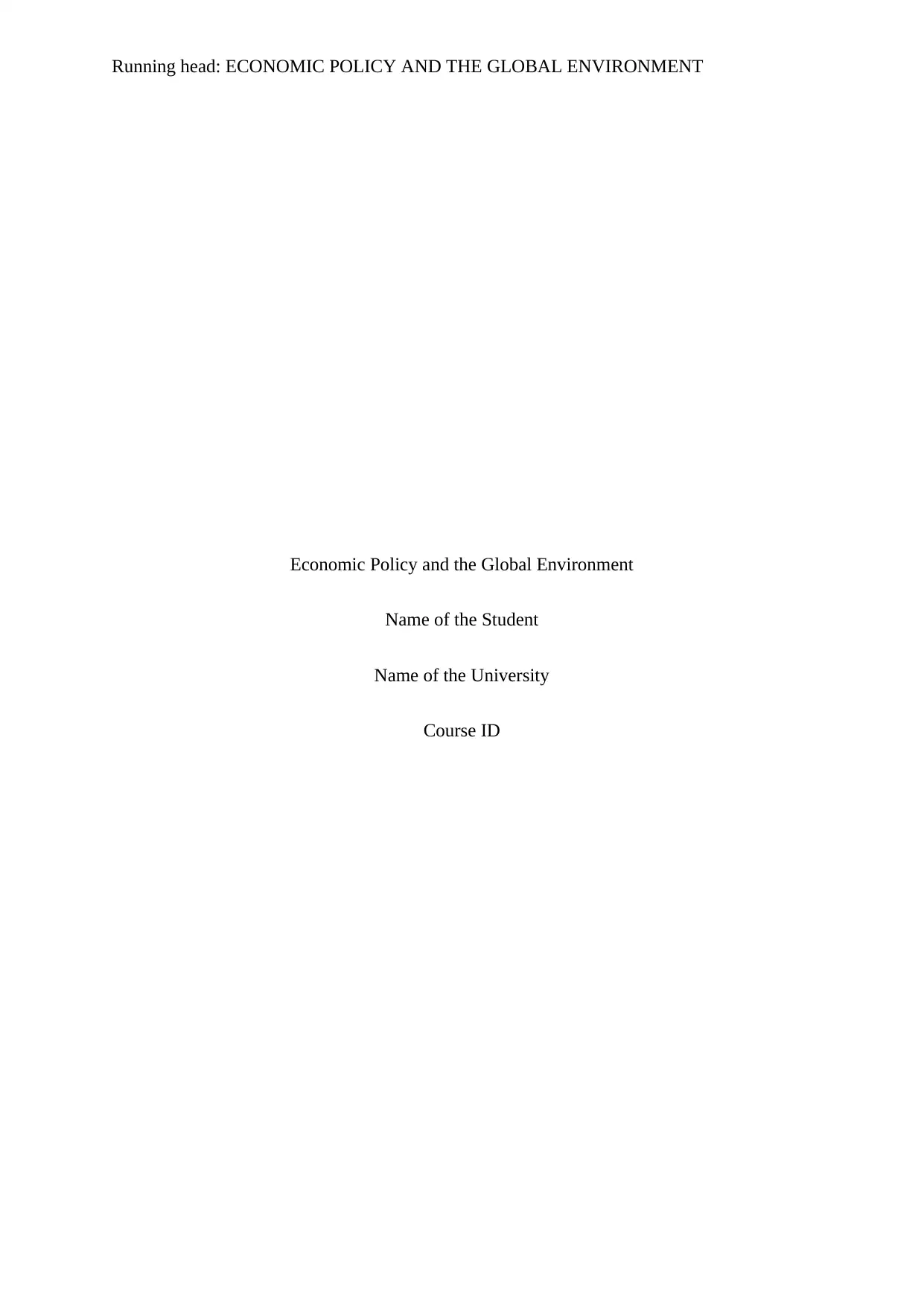
Running head: ECONOMIC POLICY AND THE GLOBAL ENVIRONMENT
Economic Policy and the Global Environment
Name of the Student
Name of the University
Course ID
Economic Policy and the Global Environment
Name of the Student
Name of the University
Course ID
Paraphrase This Document
Need a fresh take? Get an instant paraphrase of this document with our AI Paraphraser
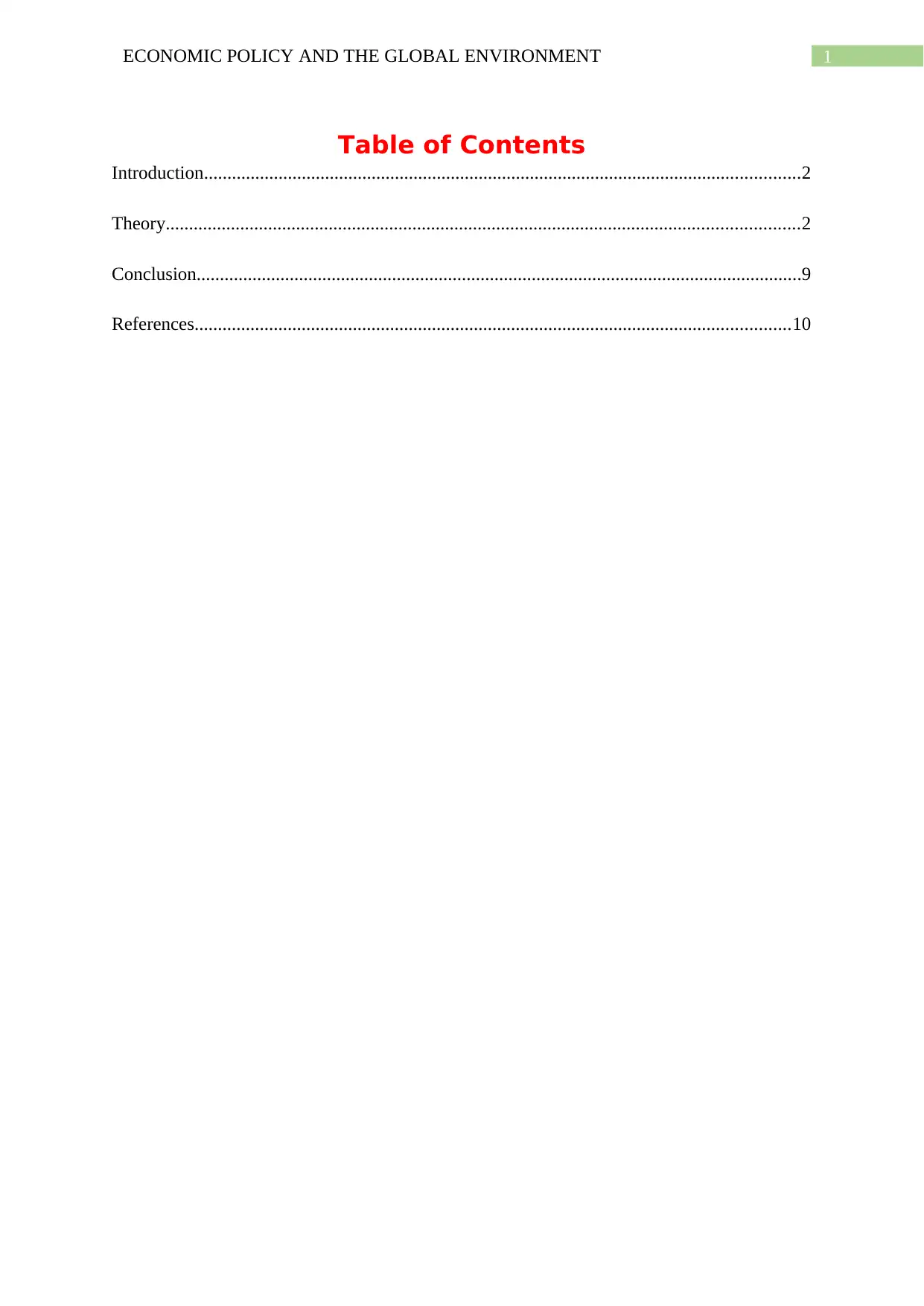
1ECONOMIC POLICY AND THE GLOBAL ENVIRONMENT
Table of Contents
Introduction................................................................................................................................2
Theory........................................................................................................................................2
Conclusion..................................................................................................................................9
References................................................................................................................................10
Table of Contents
Introduction................................................................................................................................2
Theory........................................................................................................................................2
Conclusion..................................................................................................................................9
References................................................................................................................................10
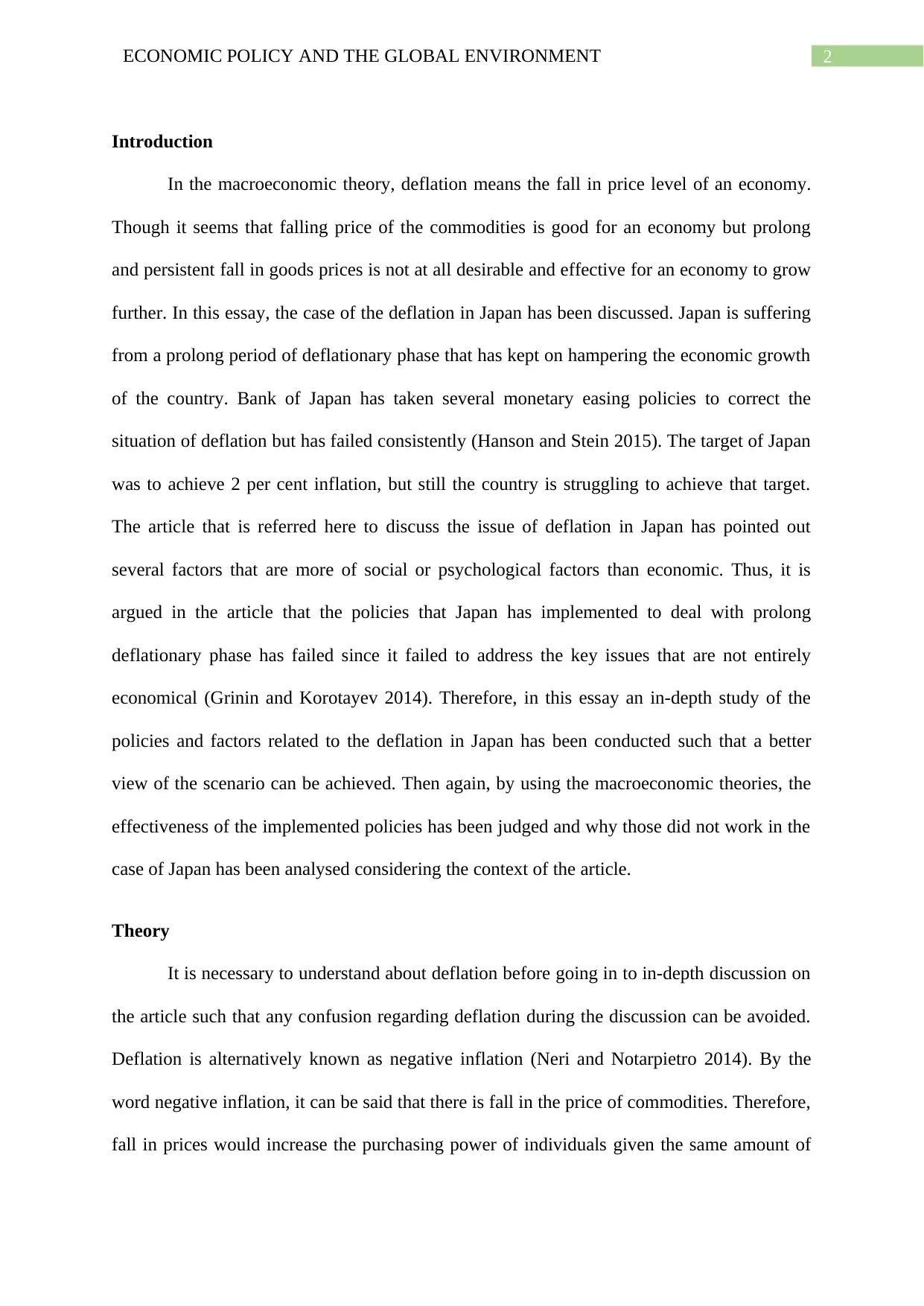
2ECONOMIC POLICY AND THE GLOBAL ENVIRONMENT
Introduction
In the macroeconomic theory, deflation means the fall in price level of an economy.
Though it seems that falling price of the commodities is good for an economy but prolong
and persistent fall in goods prices is not at all desirable and effective for an economy to grow
further. In this essay, the case of the deflation in Japan has been discussed. Japan is suffering
from a prolong period of deflationary phase that has kept on hampering the economic growth
of the country. Bank of Japan has taken several monetary easing policies to correct the
situation of deflation but has failed consistently (Hanson and Stein 2015). The target of Japan
was to achieve 2 per cent inflation, but still the country is struggling to achieve that target.
The article that is referred here to discuss the issue of deflation in Japan has pointed out
several factors that are more of social or psychological factors than economic. Thus, it is
argued in the article that the policies that Japan has implemented to deal with prolong
deflationary phase has failed since it failed to address the key issues that are not entirely
economical (Grinin and Korotayev 2014). Therefore, in this essay an in-depth study of the
policies and factors related to the deflation in Japan has been conducted such that a better
view of the scenario can be achieved. Then again, by using the macroeconomic theories, the
effectiveness of the implemented policies has been judged and why those did not work in the
case of Japan has been analysed considering the context of the article.
Theory
It is necessary to understand about deflation before going in to in-depth discussion on
the article such that any confusion regarding deflation during the discussion can be avoided.
Deflation is alternatively known as negative inflation (Neri and Notarpietro 2014). By the
word negative inflation, it can be said that there is fall in the price of commodities. Therefore,
fall in prices would increase the purchasing power of individuals given the same amount of
Introduction
In the macroeconomic theory, deflation means the fall in price level of an economy.
Though it seems that falling price of the commodities is good for an economy but prolong
and persistent fall in goods prices is not at all desirable and effective for an economy to grow
further. In this essay, the case of the deflation in Japan has been discussed. Japan is suffering
from a prolong period of deflationary phase that has kept on hampering the economic growth
of the country. Bank of Japan has taken several monetary easing policies to correct the
situation of deflation but has failed consistently (Hanson and Stein 2015). The target of Japan
was to achieve 2 per cent inflation, but still the country is struggling to achieve that target.
The article that is referred here to discuss the issue of deflation in Japan has pointed out
several factors that are more of social or psychological factors than economic. Thus, it is
argued in the article that the policies that Japan has implemented to deal with prolong
deflationary phase has failed since it failed to address the key issues that are not entirely
economical (Grinin and Korotayev 2014). Therefore, in this essay an in-depth study of the
policies and factors related to the deflation in Japan has been conducted such that a better
view of the scenario can be achieved. Then again, by using the macroeconomic theories, the
effectiveness of the implemented policies has been judged and why those did not work in the
case of Japan has been analysed considering the context of the article.
Theory
It is necessary to understand about deflation before going in to in-depth discussion on
the article such that any confusion regarding deflation during the discussion can be avoided.
Deflation is alternatively known as negative inflation (Neri and Notarpietro 2014). By the
word negative inflation, it can be said that there is fall in the price of commodities. Therefore,
fall in prices would increase the purchasing power of individuals given the same amount of
⊘ This is a preview!⊘
Do you want full access?
Subscribe today to unlock all pages.

Trusted by 1+ million students worldwide
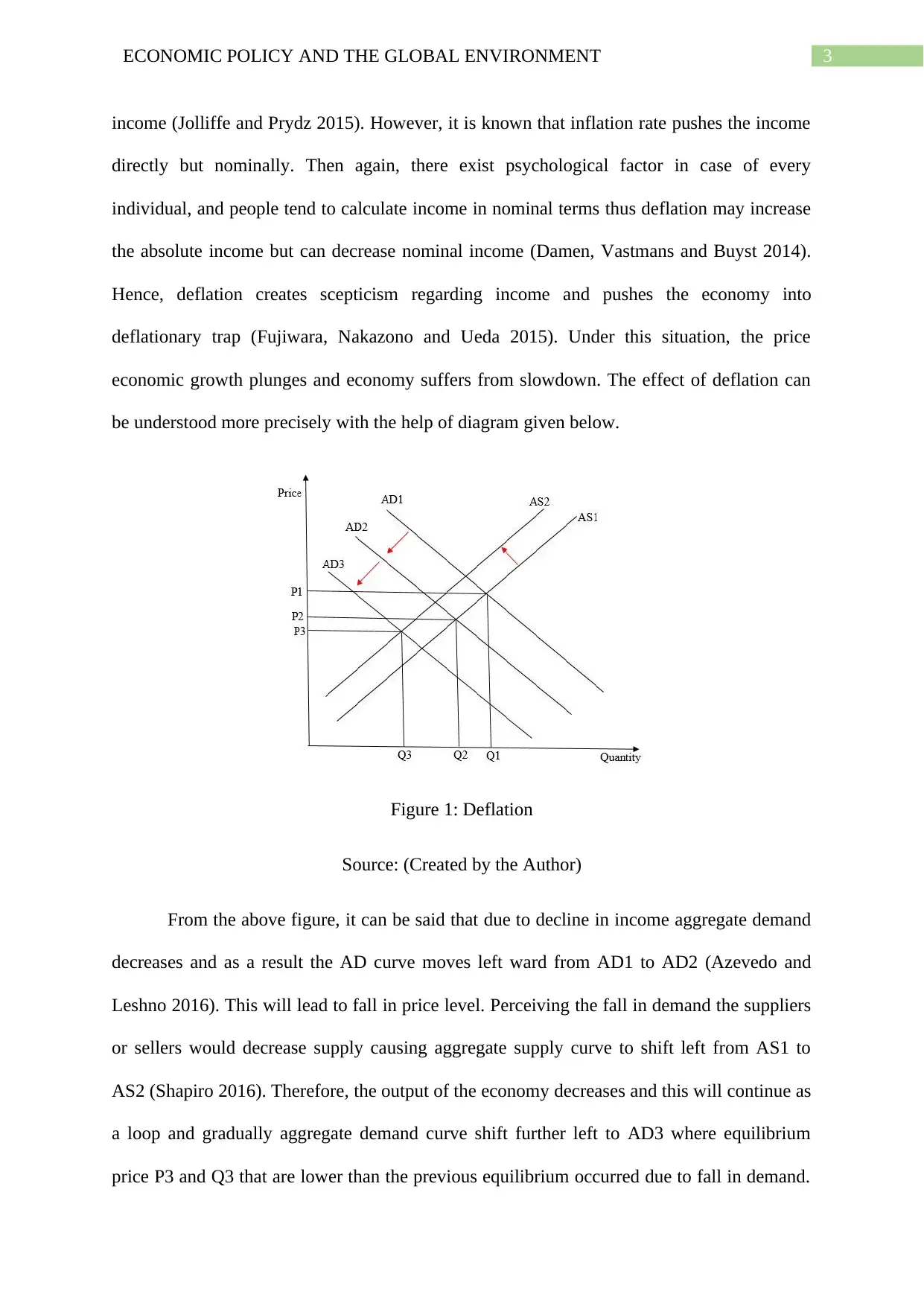
3ECONOMIC POLICY AND THE GLOBAL ENVIRONMENT
income (Jolliffe and Prydz 2015). However, it is known that inflation rate pushes the income
directly but nominally. Then again, there exist psychological factor in case of every
individual, and people tend to calculate income in nominal terms thus deflation may increase
the absolute income but can decrease nominal income (Damen, Vastmans and Buyst 2014).
Hence, deflation creates scepticism regarding income and pushes the economy into
deflationary trap (Fujiwara, Nakazono and Ueda 2015). Under this situation, the price
economic growth plunges and economy suffers from slowdown. The effect of deflation can
be understood more precisely with the help of diagram given below.
Figure 1: Deflation
Source: (Created by the Author)
From the above figure, it can be said that due to decline in income aggregate demand
decreases and as a result the AD curve moves left ward from AD1 to AD2 (Azevedo and
Leshno 2016). This will lead to fall in price level. Perceiving the fall in demand the suppliers
or sellers would decrease supply causing aggregate supply curve to shift left from AS1 to
AS2 (Shapiro 2016). Therefore, the output of the economy decreases and this will continue as
a loop and gradually aggregate demand curve shift further left to AD3 where equilibrium
price P3 and Q3 that are lower than the previous equilibrium occurred due to fall in demand.
income (Jolliffe and Prydz 2015). However, it is known that inflation rate pushes the income
directly but nominally. Then again, there exist psychological factor in case of every
individual, and people tend to calculate income in nominal terms thus deflation may increase
the absolute income but can decrease nominal income (Damen, Vastmans and Buyst 2014).
Hence, deflation creates scepticism regarding income and pushes the economy into
deflationary trap (Fujiwara, Nakazono and Ueda 2015). Under this situation, the price
economic growth plunges and economy suffers from slowdown. The effect of deflation can
be understood more precisely with the help of diagram given below.
Figure 1: Deflation
Source: (Created by the Author)
From the above figure, it can be said that due to decline in income aggregate demand
decreases and as a result the AD curve moves left ward from AD1 to AD2 (Azevedo and
Leshno 2016). This will lead to fall in price level. Perceiving the fall in demand the suppliers
or sellers would decrease supply causing aggregate supply curve to shift left from AS1 to
AS2 (Shapiro 2016). Therefore, the output of the economy decreases and this will continue as
a loop and gradually aggregate demand curve shift further left to AD3 where equilibrium
price P3 and Q3 that are lower than the previous equilibrium occurred due to fall in demand.
Paraphrase This Document
Need a fresh take? Get an instant paraphrase of this document with our AI Paraphraser
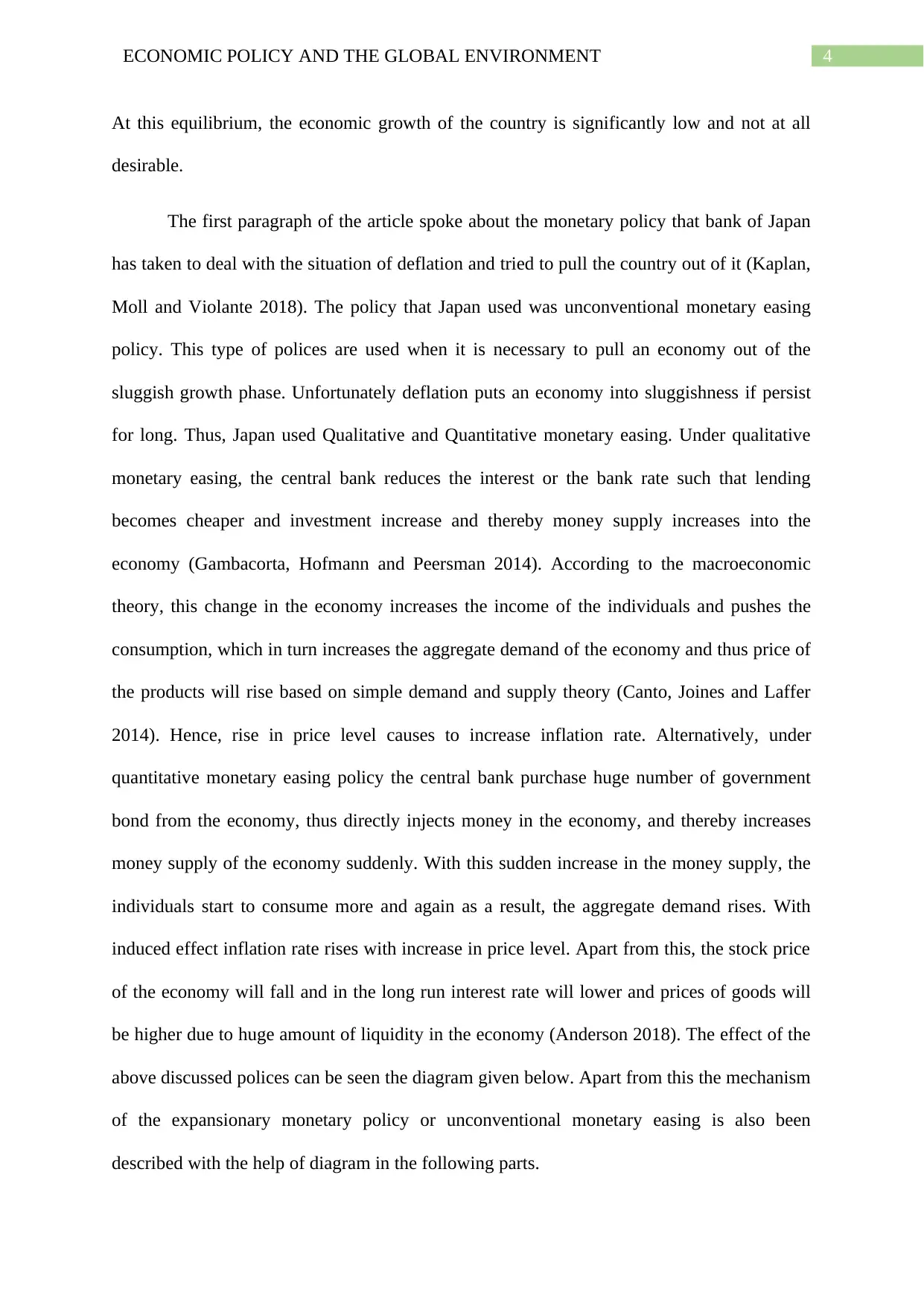
4ECONOMIC POLICY AND THE GLOBAL ENVIRONMENT
At this equilibrium, the economic growth of the country is significantly low and not at all
desirable.
The first paragraph of the article spoke about the monetary policy that bank of Japan
has taken to deal with the situation of deflation and tried to pull the country out of it (Kaplan,
Moll and Violante 2018). The policy that Japan used was unconventional monetary easing
policy. This type of polices are used when it is necessary to pull an economy out of the
sluggish growth phase. Unfortunately deflation puts an economy into sluggishness if persist
for long. Thus, Japan used Qualitative and Quantitative monetary easing. Under qualitative
monetary easing, the central bank reduces the interest or the bank rate such that lending
becomes cheaper and investment increase and thereby money supply increases into the
economy (Gambacorta, Hofmann and Peersman 2014). According to the macroeconomic
theory, this change in the economy increases the income of the individuals and pushes the
consumption, which in turn increases the aggregate demand of the economy and thus price of
the products will rise based on simple demand and supply theory (Canto, Joines and Laffer
2014). Hence, rise in price level causes to increase inflation rate. Alternatively, under
quantitative monetary easing policy the central bank purchase huge number of government
bond from the economy, thus directly injects money in the economy, and thereby increases
money supply of the economy suddenly. With this sudden increase in the money supply, the
individuals start to consume more and again as a result, the aggregate demand rises. With
induced effect inflation rate rises with increase in price level. Apart from this, the stock price
of the economy will fall and in the long run interest rate will lower and prices of goods will
be higher due to huge amount of liquidity in the economy (Anderson 2018). The effect of the
above discussed polices can be seen the diagram given below. Apart from this the mechanism
of the expansionary monetary policy or unconventional monetary easing is also been
described with the help of diagram in the following parts.
At this equilibrium, the economic growth of the country is significantly low and not at all
desirable.
The first paragraph of the article spoke about the monetary policy that bank of Japan
has taken to deal with the situation of deflation and tried to pull the country out of it (Kaplan,
Moll and Violante 2018). The policy that Japan used was unconventional monetary easing
policy. This type of polices are used when it is necessary to pull an economy out of the
sluggish growth phase. Unfortunately deflation puts an economy into sluggishness if persist
for long. Thus, Japan used Qualitative and Quantitative monetary easing. Under qualitative
monetary easing, the central bank reduces the interest or the bank rate such that lending
becomes cheaper and investment increase and thereby money supply increases into the
economy (Gambacorta, Hofmann and Peersman 2014). According to the macroeconomic
theory, this change in the economy increases the income of the individuals and pushes the
consumption, which in turn increases the aggregate demand of the economy and thus price of
the products will rise based on simple demand and supply theory (Canto, Joines and Laffer
2014). Hence, rise in price level causes to increase inflation rate. Alternatively, under
quantitative monetary easing policy the central bank purchase huge number of government
bond from the economy, thus directly injects money in the economy, and thereby increases
money supply of the economy suddenly. With this sudden increase in the money supply, the
individuals start to consume more and again as a result, the aggregate demand rises. With
induced effect inflation rate rises with increase in price level. Apart from this, the stock price
of the economy will fall and in the long run interest rate will lower and prices of goods will
be higher due to huge amount of liquidity in the economy (Anderson 2018). The effect of the
above discussed polices can be seen the diagram given below. Apart from this the mechanism
of the expansionary monetary policy or unconventional monetary easing is also been
described with the help of diagram in the following parts.
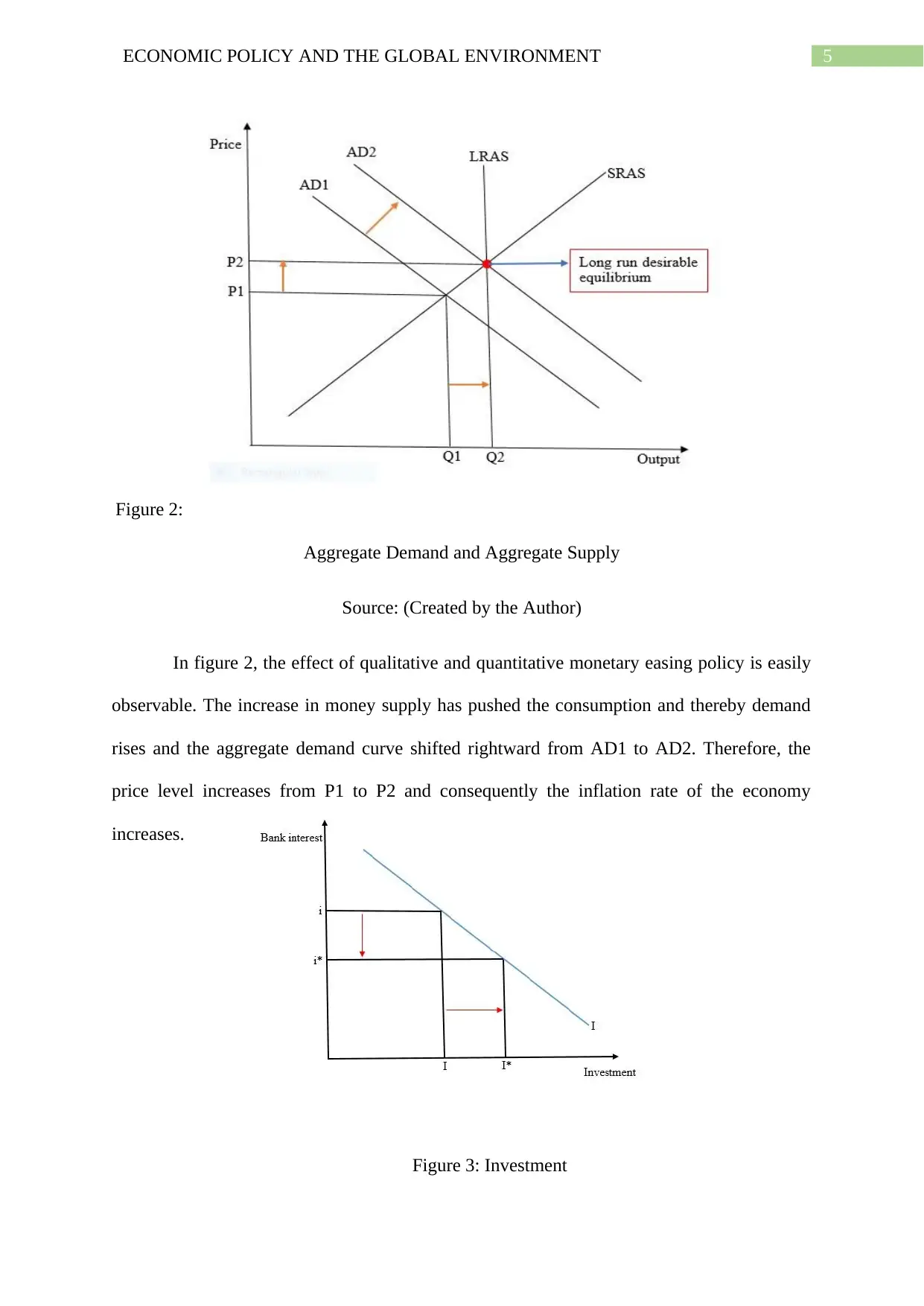
5ECONOMIC POLICY AND THE GLOBAL ENVIRONMENT
Figure 2:
Aggregate Demand and Aggregate Supply
Source: (Created by the Author)
In figure 2, the effect of qualitative and quantitative monetary easing policy is easily
observable. The increase in money supply has pushed the consumption and thereby demand
rises and the aggregate demand curve shifted rightward from AD1 to AD2. Therefore, the
price level increases from P1 to P2 and consequently the inflation rate of the economy
increases.
Figure 3: Investment
Figure 2:
Aggregate Demand and Aggregate Supply
Source: (Created by the Author)
In figure 2, the effect of qualitative and quantitative monetary easing policy is easily
observable. The increase in money supply has pushed the consumption and thereby demand
rises and the aggregate demand curve shifted rightward from AD1 to AD2. Therefore, the
price level increases from P1 to P2 and consequently the inflation rate of the economy
increases.
Figure 3: Investment
⊘ This is a preview!⊘
Do you want full access?
Subscribe today to unlock all pages.

Trusted by 1+ million students worldwide
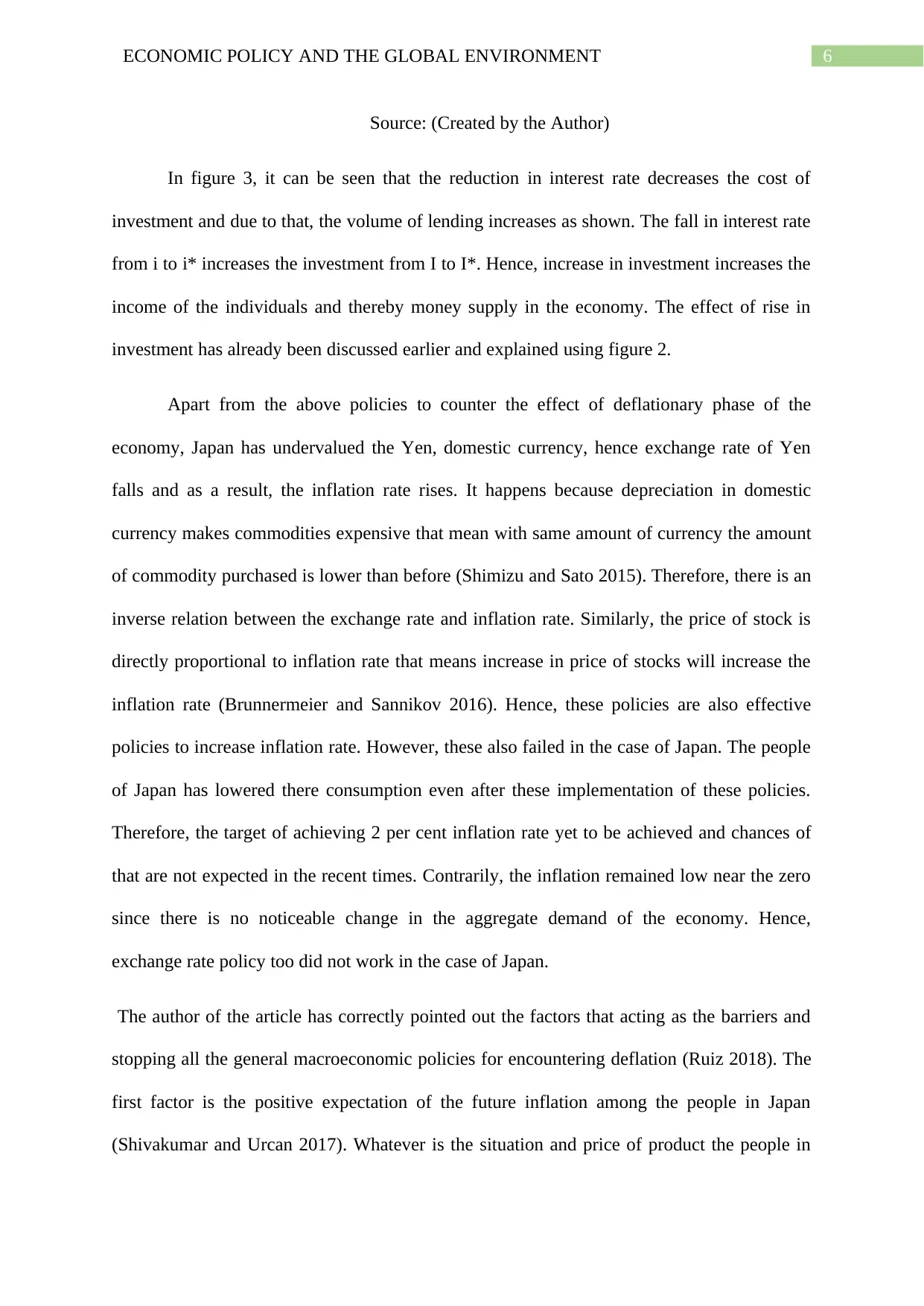
6ECONOMIC POLICY AND THE GLOBAL ENVIRONMENT
Source: (Created by the Author)
In figure 3, it can be seen that the reduction in interest rate decreases the cost of
investment and due to that, the volume of lending increases as shown. The fall in interest rate
from i to i* increases the investment from I to I*. Hence, increase in investment increases the
income of the individuals and thereby money supply in the economy. The effect of rise in
investment has already been discussed earlier and explained using figure 2.
Apart from the above policies to counter the effect of deflationary phase of the
economy, Japan has undervalued the Yen, domestic currency, hence exchange rate of Yen
falls and as a result, the inflation rate rises. It happens because depreciation in domestic
currency makes commodities expensive that mean with same amount of currency the amount
of commodity purchased is lower than before (Shimizu and Sato 2015). Therefore, there is an
inverse relation between the exchange rate and inflation rate. Similarly, the price of stock is
directly proportional to inflation rate that means increase in price of stocks will increase the
inflation rate (Brunnermeier and Sannikov 2016). Hence, these policies are also effective
policies to increase inflation rate. However, these also failed in the case of Japan. The people
of Japan has lowered there consumption even after these implementation of these policies.
Therefore, the target of achieving 2 per cent inflation rate yet to be achieved and chances of
that are not expected in the recent times. Contrarily, the inflation remained low near the zero
since there is no noticeable change in the aggregate demand of the economy. Hence,
exchange rate policy too did not work in the case of Japan.
The author of the article has correctly pointed out the factors that acting as the barriers and
stopping all the general macroeconomic policies for encountering deflation (Ruiz 2018). The
first factor is the positive expectation of the future inflation among the people in Japan
(Shivakumar and Urcan 2017). Whatever is the situation and price of product the people in
Source: (Created by the Author)
In figure 3, it can be seen that the reduction in interest rate decreases the cost of
investment and due to that, the volume of lending increases as shown. The fall in interest rate
from i to i* increases the investment from I to I*. Hence, increase in investment increases the
income of the individuals and thereby money supply in the economy. The effect of rise in
investment has already been discussed earlier and explained using figure 2.
Apart from the above policies to counter the effect of deflationary phase of the
economy, Japan has undervalued the Yen, domestic currency, hence exchange rate of Yen
falls and as a result, the inflation rate rises. It happens because depreciation in domestic
currency makes commodities expensive that mean with same amount of currency the amount
of commodity purchased is lower than before (Shimizu and Sato 2015). Therefore, there is an
inverse relation between the exchange rate and inflation rate. Similarly, the price of stock is
directly proportional to inflation rate that means increase in price of stocks will increase the
inflation rate (Brunnermeier and Sannikov 2016). Hence, these policies are also effective
policies to increase inflation rate. However, these also failed in the case of Japan. The people
of Japan has lowered there consumption even after these implementation of these policies.
Therefore, the target of achieving 2 per cent inflation rate yet to be achieved and chances of
that are not expected in the recent times. Contrarily, the inflation remained low near the zero
since there is no noticeable change in the aggregate demand of the economy. Hence,
exchange rate policy too did not work in the case of Japan.
The author of the article has correctly pointed out the factors that acting as the barriers and
stopping all the general macroeconomic policies for encountering deflation (Ruiz 2018). The
first factor is the positive expectation of the future inflation among the people in Japan
(Shivakumar and Urcan 2017). Whatever is the situation and price of product the people in
Paraphrase This Document
Need a fresh take? Get an instant paraphrase of this document with our AI Paraphraser
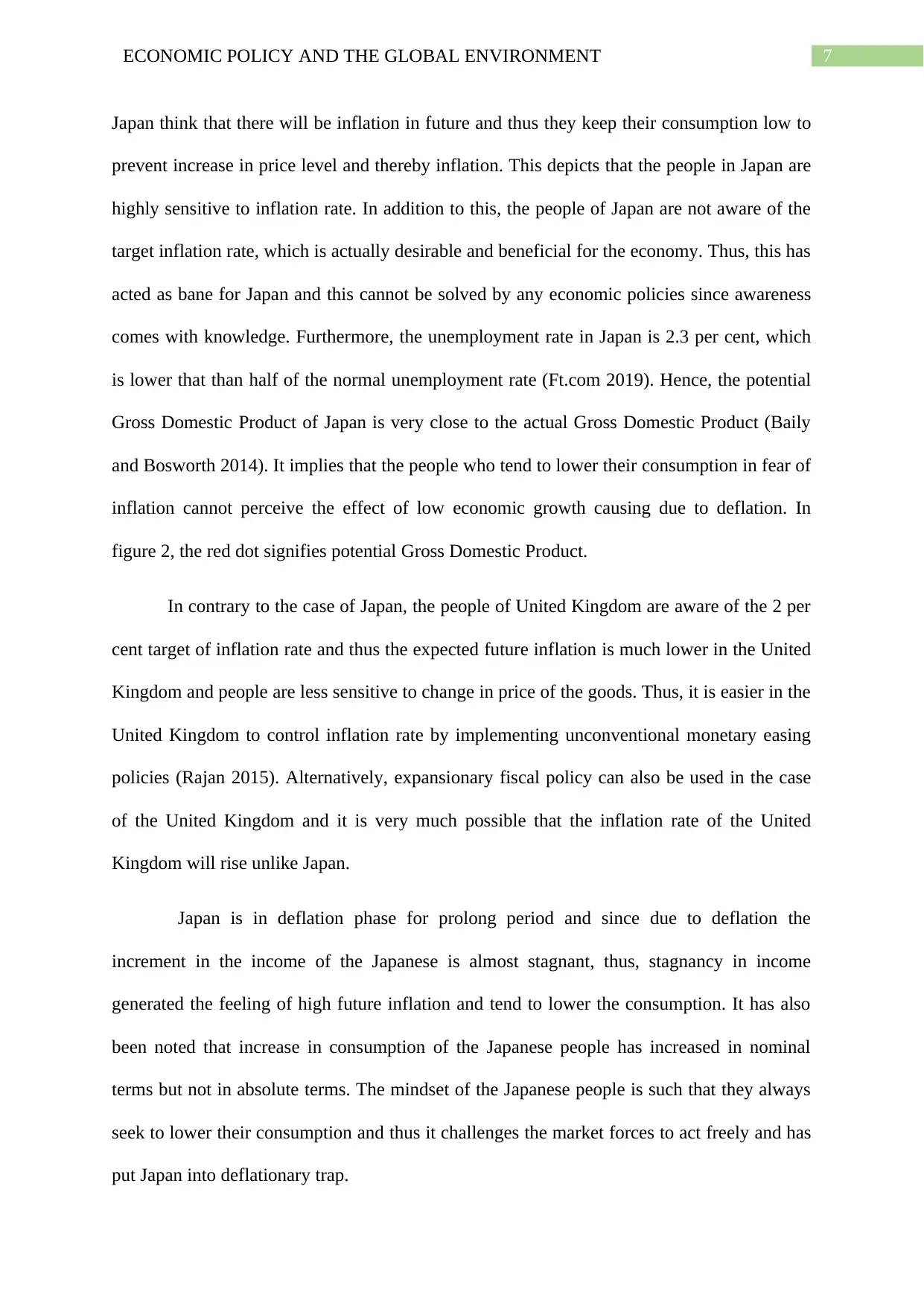
7ECONOMIC POLICY AND THE GLOBAL ENVIRONMENT
Japan think that there will be inflation in future and thus they keep their consumption low to
prevent increase in price level and thereby inflation. This depicts that the people in Japan are
highly sensitive to inflation rate. In addition to this, the people of Japan are not aware of the
target inflation rate, which is actually desirable and beneficial for the economy. Thus, this has
acted as bane for Japan and this cannot be solved by any economic policies since awareness
comes with knowledge. Furthermore, the unemployment rate in Japan is 2.3 per cent, which
is lower that than half of the normal unemployment rate (Ft.com 2019). Hence, the potential
Gross Domestic Product of Japan is very close to the actual Gross Domestic Product (Baily
and Bosworth 2014). It implies that the people who tend to lower their consumption in fear of
inflation cannot perceive the effect of low economic growth causing due to deflation. In
figure 2, the red dot signifies potential Gross Domestic Product.
In contrary to the case of Japan, the people of United Kingdom are aware of the 2 per
cent target of inflation rate and thus the expected future inflation is much lower in the United
Kingdom and people are less sensitive to change in price of the goods. Thus, it is easier in the
United Kingdom to control inflation rate by implementing unconventional monetary easing
policies (Rajan 2015). Alternatively, expansionary fiscal policy can also be used in the case
of the United Kingdom and it is very much possible that the inflation rate of the United
Kingdom will rise unlike Japan.
Japan is in deflation phase for prolong period and since due to deflation the
increment in the income of the Japanese is almost stagnant, thus, stagnancy in income
generated the feeling of high future inflation and tend to lower the consumption. It has also
been noted that increase in consumption of the Japanese people has increased in nominal
terms but not in absolute terms. The mindset of the Japanese people is such that they always
seek to lower their consumption and thus it challenges the market forces to act freely and has
put Japan into deflationary trap.
Japan think that there will be inflation in future and thus they keep their consumption low to
prevent increase in price level and thereby inflation. This depicts that the people in Japan are
highly sensitive to inflation rate. In addition to this, the people of Japan are not aware of the
target inflation rate, which is actually desirable and beneficial for the economy. Thus, this has
acted as bane for Japan and this cannot be solved by any economic policies since awareness
comes with knowledge. Furthermore, the unemployment rate in Japan is 2.3 per cent, which
is lower that than half of the normal unemployment rate (Ft.com 2019). Hence, the potential
Gross Domestic Product of Japan is very close to the actual Gross Domestic Product (Baily
and Bosworth 2014). It implies that the people who tend to lower their consumption in fear of
inflation cannot perceive the effect of low economic growth causing due to deflation. In
figure 2, the red dot signifies potential Gross Domestic Product.
In contrary to the case of Japan, the people of United Kingdom are aware of the 2 per
cent target of inflation rate and thus the expected future inflation is much lower in the United
Kingdom and people are less sensitive to change in price of the goods. Thus, it is easier in the
United Kingdom to control inflation rate by implementing unconventional monetary easing
policies (Rajan 2015). Alternatively, expansionary fiscal policy can also be used in the case
of the United Kingdom and it is very much possible that the inflation rate of the United
Kingdom will rise unlike Japan.
Japan is in deflation phase for prolong period and since due to deflation the
increment in the income of the Japanese is almost stagnant, thus, stagnancy in income
generated the feeling of high future inflation and tend to lower the consumption. It has also
been noted that increase in consumption of the Japanese people has increased in nominal
terms but not in absolute terms. The mindset of the Japanese people is such that they always
seek to lower their consumption and thus it challenges the market forces to act freely and has
put Japan into deflationary trap.
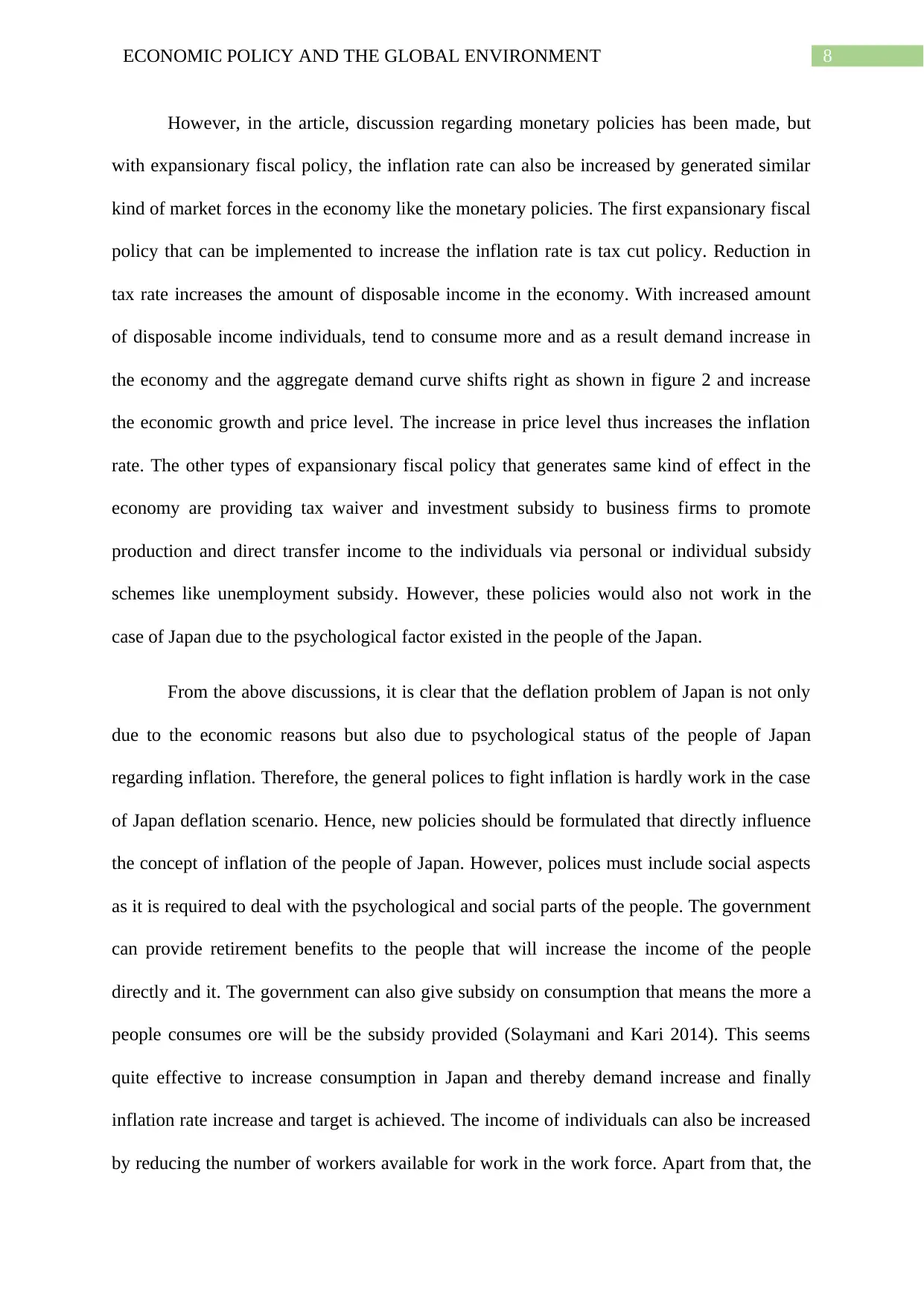
8ECONOMIC POLICY AND THE GLOBAL ENVIRONMENT
However, in the article, discussion regarding monetary policies has been made, but
with expansionary fiscal policy, the inflation rate can also be increased by generated similar
kind of market forces in the economy like the monetary policies. The first expansionary fiscal
policy that can be implemented to increase the inflation rate is tax cut policy. Reduction in
tax rate increases the amount of disposable income in the economy. With increased amount
of disposable income individuals, tend to consume more and as a result demand increase in
the economy and the aggregate demand curve shifts right as shown in figure 2 and increase
the economic growth and price level. The increase in price level thus increases the inflation
rate. The other types of expansionary fiscal policy that generates same kind of effect in the
economy are providing tax waiver and investment subsidy to business firms to promote
production and direct transfer income to the individuals via personal or individual subsidy
schemes like unemployment subsidy. However, these policies would also not work in the
case of Japan due to the psychological factor existed in the people of the Japan.
From the above discussions, it is clear that the deflation problem of Japan is not only
due to the economic reasons but also due to psychological status of the people of Japan
regarding inflation. Therefore, the general polices to fight inflation is hardly work in the case
of Japan deflation scenario. Hence, new policies should be formulated that directly influence
the concept of inflation of the people of Japan. However, polices must include social aspects
as it is required to deal with the psychological and social parts of the people. The government
can provide retirement benefits to the people that will increase the income of the people
directly and it. The government can also give subsidy on consumption that means the more a
people consumes ore will be the subsidy provided (Solaymani and Kari 2014). This seems
quite effective to increase consumption in Japan and thereby demand increase and finally
inflation rate increase and target is achieved. The income of individuals can also be increased
by reducing the number of workers available for work in the work force. Apart from that, the
However, in the article, discussion regarding monetary policies has been made, but
with expansionary fiscal policy, the inflation rate can also be increased by generated similar
kind of market forces in the economy like the monetary policies. The first expansionary fiscal
policy that can be implemented to increase the inflation rate is tax cut policy. Reduction in
tax rate increases the amount of disposable income in the economy. With increased amount
of disposable income individuals, tend to consume more and as a result demand increase in
the economy and the aggregate demand curve shifts right as shown in figure 2 and increase
the economic growth and price level. The increase in price level thus increases the inflation
rate. The other types of expansionary fiscal policy that generates same kind of effect in the
economy are providing tax waiver and investment subsidy to business firms to promote
production and direct transfer income to the individuals via personal or individual subsidy
schemes like unemployment subsidy. However, these policies would also not work in the
case of Japan due to the psychological factor existed in the people of the Japan.
From the above discussions, it is clear that the deflation problem of Japan is not only
due to the economic reasons but also due to psychological status of the people of Japan
regarding inflation. Therefore, the general polices to fight inflation is hardly work in the case
of Japan deflation scenario. Hence, new policies should be formulated that directly influence
the concept of inflation of the people of Japan. However, polices must include social aspects
as it is required to deal with the psychological and social parts of the people. The government
can provide retirement benefits to the people that will increase the income of the people
directly and it. The government can also give subsidy on consumption that means the more a
people consumes ore will be the subsidy provided (Solaymani and Kari 2014). This seems
quite effective to increase consumption in Japan and thereby demand increase and finally
inflation rate increase and target is achieved. The income of individuals can also be increased
by reducing the number of workers available for work in the work force. Apart from that, the
⊘ This is a preview!⊘
Do you want full access?
Subscribe today to unlock all pages.

Trusted by 1+ million students worldwide
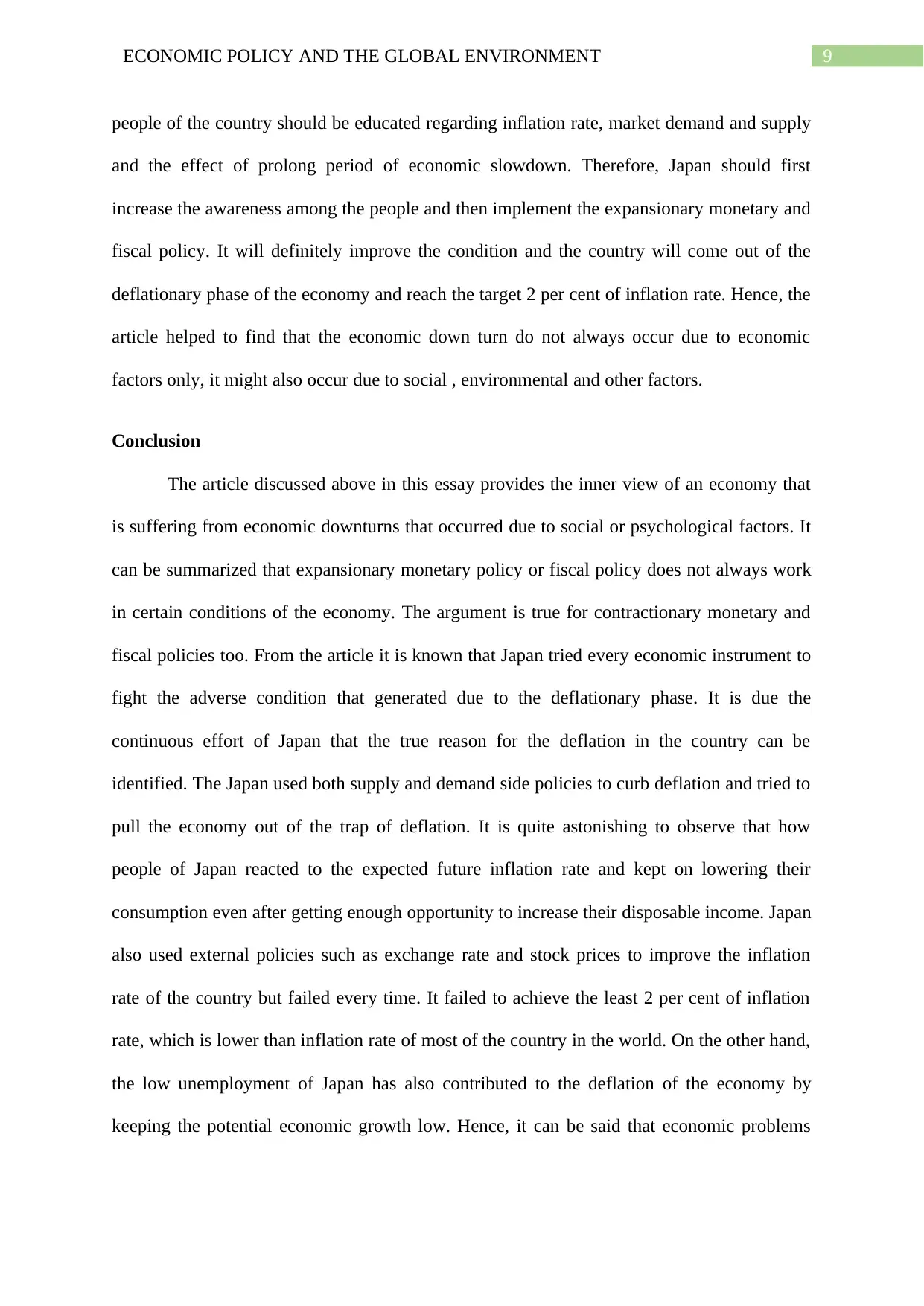
9ECONOMIC POLICY AND THE GLOBAL ENVIRONMENT
people of the country should be educated regarding inflation rate, market demand and supply
and the effect of prolong period of economic slowdown. Therefore, Japan should first
increase the awareness among the people and then implement the expansionary monetary and
fiscal policy. It will definitely improve the condition and the country will come out of the
deflationary phase of the economy and reach the target 2 per cent of inflation rate. Hence, the
article helped to find that the economic down turn do not always occur due to economic
factors only, it might also occur due to social , environmental and other factors.
Conclusion
The article discussed above in this essay provides the inner view of an economy that
is suffering from economic downturns that occurred due to social or psychological factors. It
can be summarized that expansionary monetary policy or fiscal policy does not always work
in certain conditions of the economy. The argument is true for contractionary monetary and
fiscal policies too. From the article it is known that Japan tried every economic instrument to
fight the adverse condition that generated due to the deflationary phase. It is due the
continuous effort of Japan that the true reason for the deflation in the country can be
identified. The Japan used both supply and demand side policies to curb deflation and tried to
pull the economy out of the trap of deflation. It is quite astonishing to observe that how
people of Japan reacted to the expected future inflation rate and kept on lowering their
consumption even after getting enough opportunity to increase their disposable income. Japan
also used external policies such as exchange rate and stock prices to improve the inflation
rate of the country but failed every time. It failed to achieve the least 2 per cent of inflation
rate, which is lower than inflation rate of most of the country in the world. On the other hand,
the low unemployment of Japan has also contributed to the deflation of the economy by
keeping the potential economic growth low. Hence, it can be said that economic problems
people of the country should be educated regarding inflation rate, market demand and supply
and the effect of prolong period of economic slowdown. Therefore, Japan should first
increase the awareness among the people and then implement the expansionary monetary and
fiscal policy. It will definitely improve the condition and the country will come out of the
deflationary phase of the economy and reach the target 2 per cent of inflation rate. Hence, the
article helped to find that the economic down turn do not always occur due to economic
factors only, it might also occur due to social , environmental and other factors.
Conclusion
The article discussed above in this essay provides the inner view of an economy that
is suffering from economic downturns that occurred due to social or psychological factors. It
can be summarized that expansionary monetary policy or fiscal policy does not always work
in certain conditions of the economy. The argument is true for contractionary monetary and
fiscal policies too. From the article it is known that Japan tried every economic instrument to
fight the adverse condition that generated due to the deflationary phase. It is due the
continuous effort of Japan that the true reason for the deflation in the country can be
identified. The Japan used both supply and demand side policies to curb deflation and tried to
pull the economy out of the trap of deflation. It is quite astonishing to observe that how
people of Japan reacted to the expected future inflation rate and kept on lowering their
consumption even after getting enough opportunity to increase their disposable income. Japan
also used external policies such as exchange rate and stock prices to improve the inflation
rate of the country but failed every time. It failed to achieve the least 2 per cent of inflation
rate, which is lower than inflation rate of most of the country in the world. On the other hand,
the low unemployment of Japan has also contributed to the deflation of the economy by
keeping the potential economic growth low. Hence, it can be said that economic problems
Paraphrase This Document
Need a fresh take? Get an instant paraphrase of this document with our AI Paraphraser
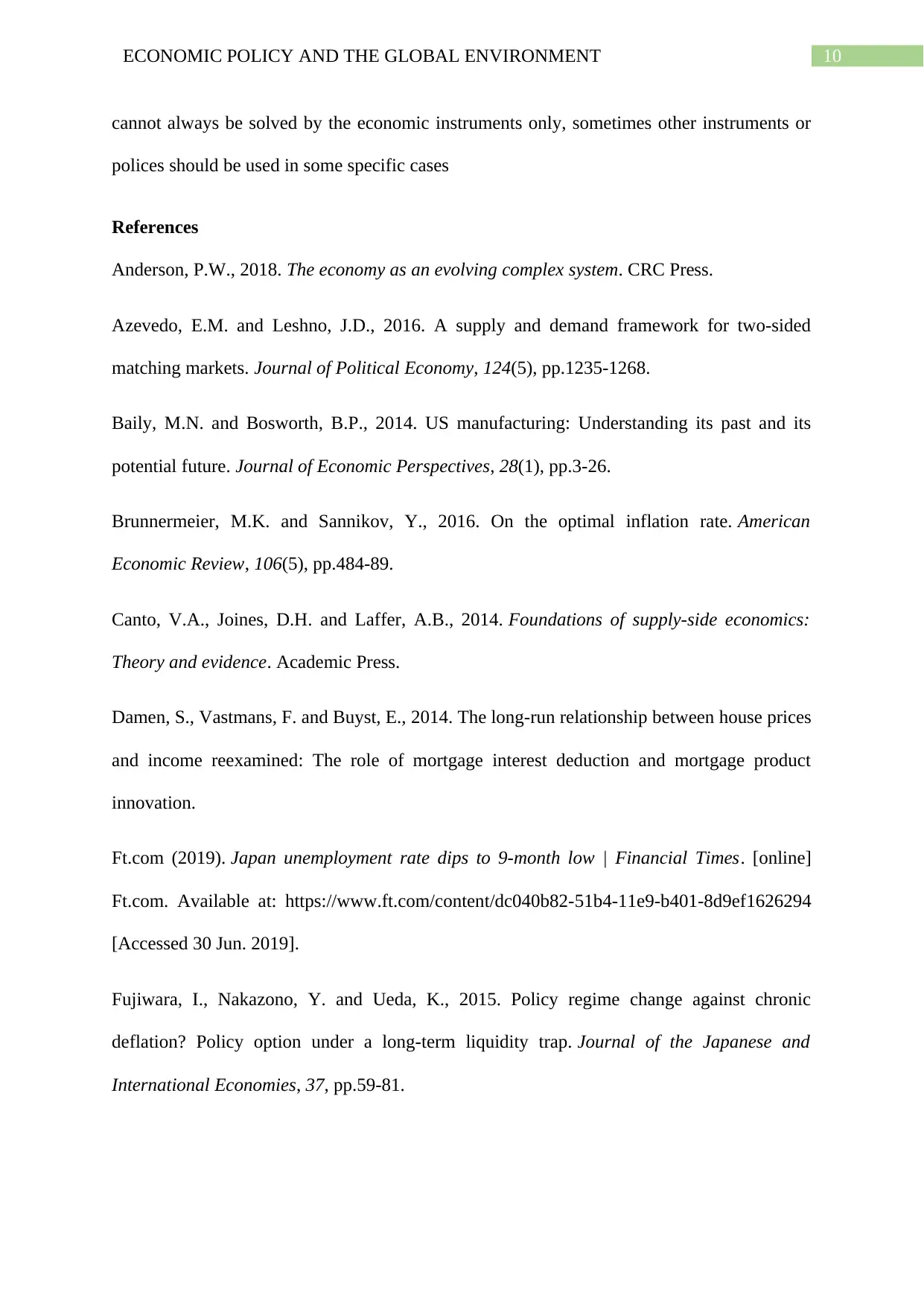
10ECONOMIC POLICY AND THE GLOBAL ENVIRONMENT
cannot always be solved by the economic instruments only, sometimes other instruments or
polices should be used in some specific cases
References
Anderson, P.W., 2018. The economy as an evolving complex system. CRC Press.
Azevedo, E.M. and Leshno, J.D., 2016. A supply and demand framework for two-sided
matching markets. Journal of Political Economy, 124(5), pp.1235-1268.
Baily, M.N. and Bosworth, B.P., 2014. US manufacturing: Understanding its past and its
potential future. Journal of Economic Perspectives, 28(1), pp.3-26.
Brunnermeier, M.K. and Sannikov, Y., 2016. On the optimal inflation rate. American
Economic Review, 106(5), pp.484-89.
Canto, V.A., Joines, D.H. and Laffer, A.B., 2014. Foundations of supply-side economics:
Theory and evidence. Academic Press.
Damen, S., Vastmans, F. and Buyst, E., 2014. The long-run relationship between house prices
and income reexamined: The role of mortgage interest deduction and mortgage product
innovation.
Ft.com (2019). Japan unemployment rate dips to 9-month low | Financial Times. [online]
Ft.com. Available at: https://www.ft.com/content/dc040b82-51b4-11e9-b401-8d9ef1626294
[Accessed 30 Jun. 2019].
Fujiwara, I., Nakazono, Y. and Ueda, K., 2015. Policy regime change against chronic
deflation? Policy option under a long-term liquidity trap. Journal of the Japanese and
International Economies, 37, pp.59-81.
cannot always be solved by the economic instruments only, sometimes other instruments or
polices should be used in some specific cases
References
Anderson, P.W., 2018. The economy as an evolving complex system. CRC Press.
Azevedo, E.M. and Leshno, J.D., 2016. A supply and demand framework for two-sided
matching markets. Journal of Political Economy, 124(5), pp.1235-1268.
Baily, M.N. and Bosworth, B.P., 2014. US manufacturing: Understanding its past and its
potential future. Journal of Economic Perspectives, 28(1), pp.3-26.
Brunnermeier, M.K. and Sannikov, Y., 2016. On the optimal inflation rate. American
Economic Review, 106(5), pp.484-89.
Canto, V.A., Joines, D.H. and Laffer, A.B., 2014. Foundations of supply-side economics:
Theory and evidence. Academic Press.
Damen, S., Vastmans, F. and Buyst, E., 2014. The long-run relationship between house prices
and income reexamined: The role of mortgage interest deduction and mortgage product
innovation.
Ft.com (2019). Japan unemployment rate dips to 9-month low | Financial Times. [online]
Ft.com. Available at: https://www.ft.com/content/dc040b82-51b4-11e9-b401-8d9ef1626294
[Accessed 30 Jun. 2019].
Fujiwara, I., Nakazono, Y. and Ueda, K., 2015. Policy regime change against chronic
deflation? Policy option under a long-term liquidity trap. Journal of the Japanese and
International Economies, 37, pp.59-81.
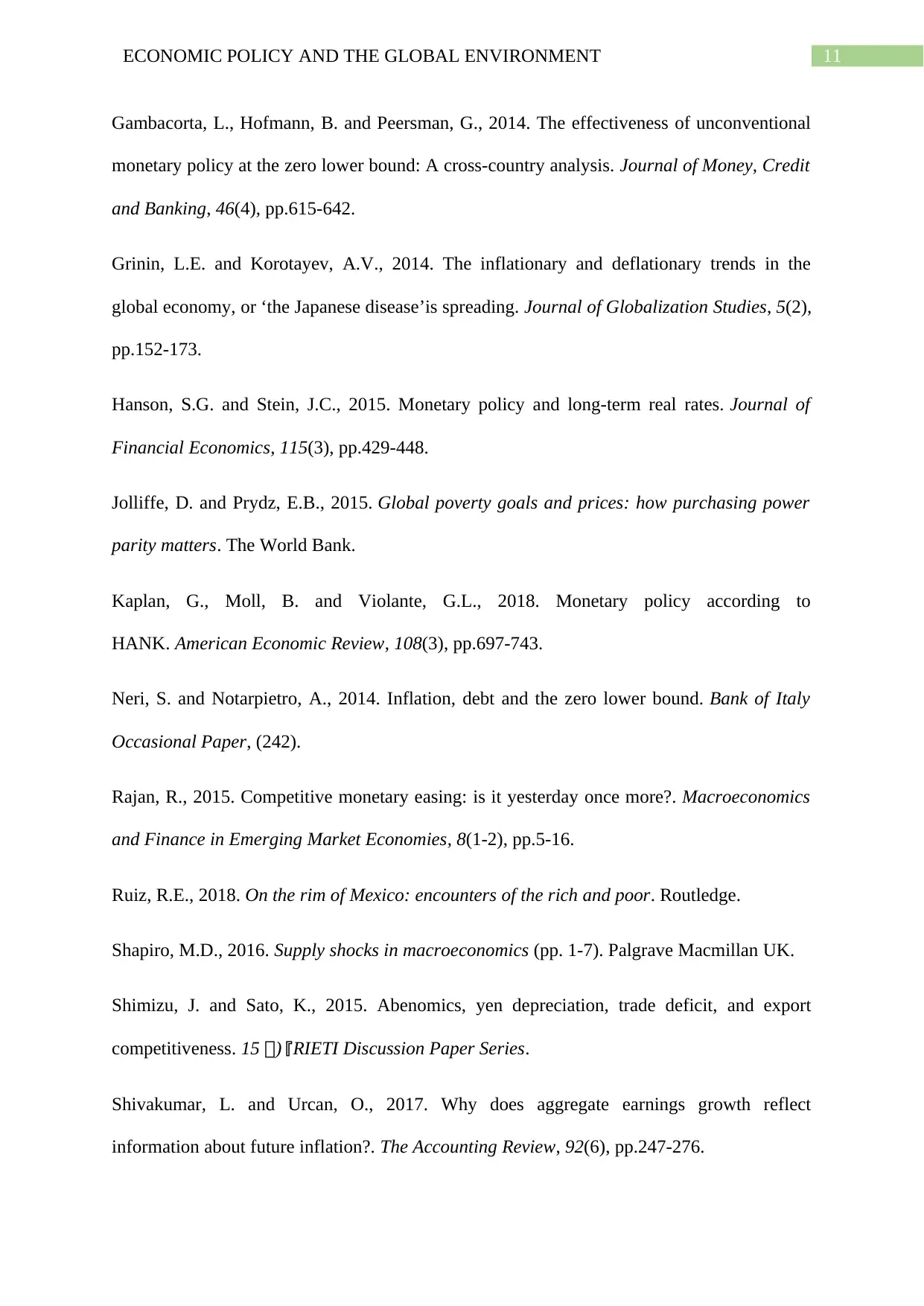
11ECONOMIC POLICY AND THE GLOBAL ENVIRONMENT
Gambacorta, L., Hofmann, B. and Peersman, G., 2014. The effectiveness of unconventional
monetary policy at the zero lower bound: A cross‐country analysis. Journal of Money, Credit
and Banking, 46(4), pp.615-642.
Grinin, L.E. and Korotayev, A.V., 2014. The inflationary and deflationary trends in the
global economy, or ‘the Japanese disease’is spreading. Journal of Globalization Studies, 5(2),
pp.152-173.
Hanson, S.G. and Stein, J.C., 2015. Monetary policy and long-term real rates. Journal of
Financial Economics, 115(3), pp.429-448.
Jolliffe, D. and Prydz, E.B., 2015. Global poverty goals and prices: how purchasing power
parity matters. The World Bank.
Kaplan, G., Moll, B. and Violante, G.L., 2018. Monetary policy according to
HANK. American Economic Review, 108(3), pp.697-743.
Neri, S. and Notarpietro, A., 2014. Inflation, debt and the zero lower bound. Bank of Italy
Occasional Paper, (242).
Rajan, R., 2015. Competitive monetary easing: is it yesterday once more?. Macroeconomics
and Finance in Emerging Market Economies, 8(1-2), pp.5-16.
Ruiz, R.E., 2018. On the rim of Mexico: encounters of the rich and poor. Routledge.
Shapiro, M.D., 2016. Supply shocks in macroeconomics (pp. 1-7). Palgrave Macmillan UK.
Shimizu, J. and Sato, K., 2015. Abenomics, yen depreciation, trade deficit, and export
competitiveness. 15 年)『RIETI Discussion Paper Series.
Shivakumar, L. and Urcan, O., 2017. Why does aggregate earnings growth reflect
information about future inflation?. The Accounting Review, 92(6), pp.247-276.
Gambacorta, L., Hofmann, B. and Peersman, G., 2014. The effectiveness of unconventional
monetary policy at the zero lower bound: A cross‐country analysis. Journal of Money, Credit
and Banking, 46(4), pp.615-642.
Grinin, L.E. and Korotayev, A.V., 2014. The inflationary and deflationary trends in the
global economy, or ‘the Japanese disease’is spreading. Journal of Globalization Studies, 5(2),
pp.152-173.
Hanson, S.G. and Stein, J.C., 2015. Monetary policy and long-term real rates. Journal of
Financial Economics, 115(3), pp.429-448.
Jolliffe, D. and Prydz, E.B., 2015. Global poverty goals and prices: how purchasing power
parity matters. The World Bank.
Kaplan, G., Moll, B. and Violante, G.L., 2018. Monetary policy according to
HANK. American Economic Review, 108(3), pp.697-743.
Neri, S. and Notarpietro, A., 2014. Inflation, debt and the zero lower bound. Bank of Italy
Occasional Paper, (242).
Rajan, R., 2015. Competitive monetary easing: is it yesterday once more?. Macroeconomics
and Finance in Emerging Market Economies, 8(1-2), pp.5-16.
Ruiz, R.E., 2018. On the rim of Mexico: encounters of the rich and poor. Routledge.
Shapiro, M.D., 2016. Supply shocks in macroeconomics (pp. 1-7). Palgrave Macmillan UK.
Shimizu, J. and Sato, K., 2015. Abenomics, yen depreciation, trade deficit, and export
competitiveness. 15 年)『RIETI Discussion Paper Series.
Shivakumar, L. and Urcan, O., 2017. Why does aggregate earnings growth reflect
information about future inflation?. The Accounting Review, 92(6), pp.247-276.
⊘ This is a preview!⊘
Do you want full access?
Subscribe today to unlock all pages.

Trusted by 1+ million students worldwide
1 out of 13
Related Documents
Your All-in-One AI-Powered Toolkit for Academic Success.
+13062052269
info@desklib.com
Available 24*7 on WhatsApp / Email
![[object Object]](/_next/static/media/star-bottom.7253800d.svg)
Unlock your academic potential
Copyright © 2020–2025 A2Z Services. All Rights Reserved. Developed and managed by ZUCOL.



